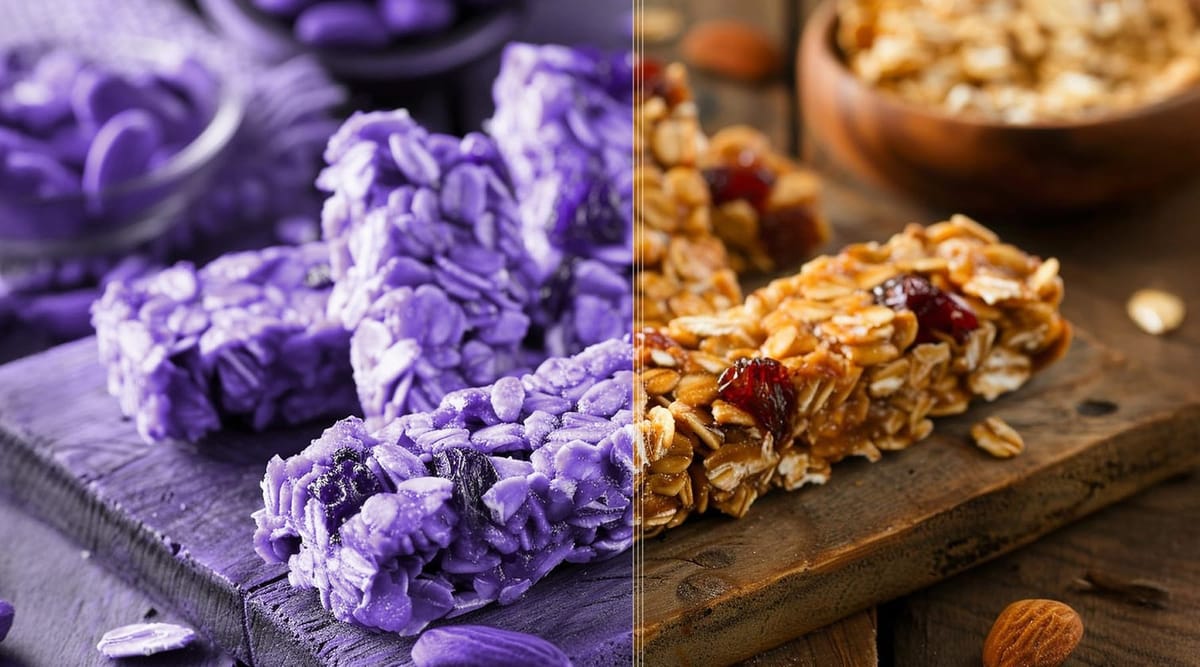What are Factors Influencing the Landscape of Energy Bars in India
The Indian energy bar market has grown almost 199.6bn in 2023 and is rapidly growing at a rate of 1.8% with increasing wellness and fitness awareness among the Indian common man, rising influence of fitness influencers and post pandemic health-consciousness among people.

Proteins are naturally occurring macro-nutrients made up of building blocks called amino that help build muscle growth, repair, and maintenance. A sedentary adult is advised to have 0.8 grams of protein per kilogram of body weight as per the dietitians. Day-by-day health consciousness rises in the market, particularly among fitness enthusiasts and even the typical Indian middle class is getting more and more health-conscious, and so is their concern and vigilance about their diet that only signifies how the market for fitness and wellness-focused products is growing at a fast pace. Energy bars are easy, convenient, and price-friendly- a combination that appeals to the Indian consumer the most and is becoming an emerging choice in Indian snacks.
The Indian energy bar market has grown by almost 199.6bn in 2023. It is rapidly growing at a rate of 1.8% with increasing wellness and fitness awareness among the Indian common man, rising influence of fitness influencers, and post-pandemic health-consciousness among people. If you’re looking for ways to step foot and expand in this market, you’ve come to the right place. This blog will outline for you insights that will give you the right perspective and move in the direction of elevating growth.
Strategic Growth Opportunities for the Producers:
Rise in Plant-Based Diets Results in Demand for Natural and Vegan Based Products
The global shifts towards plant-based diets have been making significant growth in India with several people turning to solely plant-based alternatives and food items. This trend is particularly emerging within the younger demographic noticeably. This has resulted in the rise in demand for natural and vegan-based products, particularly among Gen-Z, millennials, and urban consumers who are more mindful about their consumption patterns and environmental issues.
With a market share of 57% plant-based products among the energy and protein bars is emerging as a leading option
Implications for Growth:
- Carrying out product diversification: The rise in demand for plant-based products means that companies and producers might need to expand and step foot into other products such as the likes of vegan energy and protein bars etc. to appeal to the new consumer segment that is plant-forward and environmental in their cause.
- Market Expansion: By catering to the plant-based trend companies can tap into a lucrative market of emerging consumer segments such as the likes of flexitarians and individuals with dietary restrictions etc.
- Changes in the supply chain management: Leading changes in the demand for the product can lead to significant changes in the supply chain management and production techniques for the manufacturer. Producers might need to make changes to cater to the more environmentally conscious segment and to cut back on the extra operational costs that might emerge in sourcing high-quality materials and appliances.
Preference for Sustainable and Eco-Friendly Packaging Solutions
Environmental sustainability and production practices are becoming an important factor in consumer purchasing decisions. Consumers usually prefer products that are organic and eco-friendly in their production practices. As a result, demand for sustainable production and packaging is preferred and on the rise in the energy bar market.
Implications for Businesses: -
- Innovations in packaging: With new trends emerging companies to differentiate themselves in their packaging. There needs to be continuous innovations in packaging such as the use of bio-degradable materials, reusable boxes, or even edible packaging to meet the customer’s expectations and demands.
- Brand positioning and enhancement: Companies that can successfully integrate environmentally friendly practices into packaging processes as well stand to enhance their brand image by capturing the environmentally conscious customer segment and gaining a competitive advantage over other competitors.
- Cost Reduction: While sustainable packaging has become necessary especially to meet customer expectations, it also comes at a higher production cost. Companies need to balance sustainable manufacturing with cost reduction as well as the consumer’s willingness to pay for sustainable packaging by methods such as premium subscriptions, etc.
Increasing Influence of Fitness Professionals and Health Influencers
With the increase in social media users across India and health and wellness trends, fitness influencers are having a huge impact on end-users across Instagram, YouTube, etc. Moreover, the rise of fitness influencers on social media platforms like Instagram and YouTube has led to a surge in health-conscious followers, with the fitness and wellness category witnessing a 75% increase in engagement over the past year. People trust the recommendations from fitness and health-based influencers as they practice what they suggest which increases their trustworthiness. Brands that are collaborating with influencers to market their products see effective results, ultimately fuelling market growth in the industry.
Implications for businesses :
- Collaborating with fitness influencers: By tapping into the vast following of fitness influencers brands can advertise themselves to the general public and effectively reach their target audience. Brands can participate in collaborations which can be of various forms such as PR packages, sponsorship, etc.
- Building the digital footprint of the brand: In the era of social media and the internet, it is now necessary for brands to invest in social media marketing and stay relevant on social media by building their online presence and connecting with their target audience. This can be done by creating engaging content, advertisement campaigns, and building a strong presence on social media platforms such as YouTube and Instagram.
- Emphasizing the authenticity: With customers being highly aware of their health and values, brands that are transparent with their processes and are authentic in their ways are valued much higher in customer preferences. By being open with the nutritional information, and production processes and collaborating with influencers that are authentic and prioritize health and transparency among their audience brands can aim to develop an authentic image true to the customer values.
Rise in E-Commerce platforms and other retail channels: -
After supermarkets and hypermarkets, online platforms are emerging as the main channel for sales for energy bars in India. With supermarkets and hypermarkets capturing a share of 38.12%, online e-commerce platforms emerged as the most productive with a share of 18%. E-commerce platforms such as Blink-it, Swiggy-Instamart, and Zomato are emerging as strong contenders for the sales of energy and protein bars in India. Online platforms come across as more convenient and time-saving for consumers and manufacturers alike. With quick delivery mediums, saving on operational costs e-commerce, and offering an ample number of options to choose from have made e-commerce platforms an attractive opportunity to invest in.
Implications for businesses-
- Increased consumer engagement: E-commerce platform channels provide brands with a threshold to engage and interact with customers more. Brands can use advertising strategies, customer feedback, polls, surveys, etc. to view consumer opinion and strategically broaden their reach through feedback.
- Omnichannel integration: With the rise in e-commerce platforms, companies need to integrate their online sales channels with their offline ones to increase sales. E-commerce in India is expected to grow at a rate of 25-30% annually, soon crossing over the US consumer base for e-commerce platforms.
- Data-driven decisions: Using data analytics to make strategic decisions and understanding customer preferences and buying decisions can help companies optimize their product offerings and marketing strategies.
Integrating Technology with Personalized Nutrition the Right Way: EatFit
Eatfit, a residing subsidiary of Curefoods has been coming up as one of the leading brands in the Indian health food market, including energy bars. The brand is well known for integrating technology with nutrition and creating a personalized health experience for its customers. EatFit leveraged the growing influence of social media influencers and technological advancements to its advantage and saw tremendous growth in revenue and customer retention.
Key Strategies:
- Integrating technology: - EatFit is well known for leveraging technological means such as algorithms and machine learning to provide personalized recommendations based on customer preferences such as nutritional needs, past purchases, and dietary preferences. Integrating such technology into its customer experience helps enhance customer retention.
- Multichannel presence: While EatFit primarily operates through its app and website, it has also established a well-known presence on online food ordering apps such as Zomato, Swiggy, Blinkit, etc. This multichannel approach ensures the customer of the brand’s easy approach and convenience.
- Focus on healthy eating: EatFit focuses on building a clean brand for itself with its energy bars made of high-quality, well-preserved, and fresh ingredients. Primarily targeting and re-assuring the new emerging consumer base that is highly conscious of their dietary preferences and nutritional needs it caters to the dynamic customer base.
Results
- Market Penetration and Growth: EatFit reported a $50 million revenue for the year 2022 which can be attributed to its technologically advanced approach to its customer experience and quality products which are health-centric focused.
- Expanded User Base: According to Ankit Nagori, the co-founder of CureFoods with a combination of memberships and subscription programs, EatFit enjoys a 70% consumer retention and customer loyalty rates. By offering customers a larger engagement experience and catering to their consumption habits, EatFit has been able to build an expanded loyal customer base that only seems to be growing
EatFit has managed to become a well-known brand in the newly emerging healthy foods market, one of the few upcoming leaders of this industry thanks to its forward-thinking approach and specifically catering to every one of its customers’ needs and preferences with the help of technological advancements and AI.
Future Outlook of India Energy Bar Sector
Market is Set to Reach USD 284.7 Bn by 2029
The India Energy Bar Market has reached USD 199.6 Bn in 2023 at a growth rate of 1.8% during the historic period 2018-2023 and is expected to reach USD 284.7 Bn by 2029. The market is growing at a fast pace and the numbers can be attributed to growth in the health and wellness sector with people growing more health-conscious post-pandemic, rising influence of fitness influencers, and changing consumer preferences in general with customers growing more and more aware about the benefits of staying healthy, etc.
Diverse Consumer Base Driving India’s Energy Bar Market
The Indian consumer market for energy bars is diversely distributed among health and fitness enthusiasts, busy individuals and the workforce, and health-conscious people. Such a large base of consumers provides plenty of growth areas for the brands to establish a name for their products in the market. There has been a noticeable increase in searches and discussions on social media platforms regarding terms such as "healthy snacks," "nutritious foods," and "protein-rich snacks." This surge suggests a growing inclination towards healthier eating habits among consumers.
Bridging the Urban-Rural Divide in India’s Energy Bar Sector
While being all the rage in the market right now, especially for professionals within the sports and fitness industry, energy bars are only available in about 10% of retail outlets in India. Market penetration for energy bars is a complicated issue due to the availability of the product and price issues. Energy bars are popularly only available in mostly urban cities such as Bangalore, Mumbai, and Delhi. It has yet to form its customer base in rural areas and tier 3 cities. This urban-centric approach provides a unique opportunity for the producers to expand into rural regions and markets that make up approximately 65% of the pollution. While it remains an issue that Indian customers are mostly price sensitive it also presents a growth opportunity for the producers to tap into these markets and appeal to the customers by competitive pricing strategies, discounts, etc., and developing cost-effective products that cater to this consumer market.
Conclusion
The Indian Energy Bar market is a growing opportunity in India for companies to capture and grow within. Growing trends and increasing health importance and awareness a key players in this market. As the market evolves, companies should look to capitalize on the changing customer preferences and convenience. By focusing on the market dynamic, the rise of e-commerce, and social media, brands can focus on building a brand/product that is efficient and fruitful.


